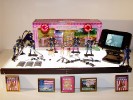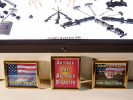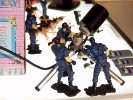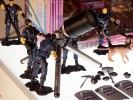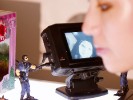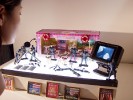What Makes Today’s Home So, 2004
What Makes Today’s Home So Secure, So Appealing? is a 11″h x 17″d x 24″w Mixed media sculpture involving a light box, children’s toys, a working infra red video camera and 4″ monitor.
Â
Project Description:
Coming to my art studio in the Lower East Side a day after 9/11, I had to pass two different police road blocks. At the second one an officer stopped me. Ten minutes later someone else on duty let me pass. I was grateful, but chilled by the experience. Who was in charge? What rules were they following? The security was for my safety, yet was directed against me. I had a sudden gut impression. What if a totalitarian state seized control of this nation from the inside? The rhetoric would still all be pro America, but there would be no free nation left.
Tomorrow seems to have already arrived. Americans detained without due process. Wholesale spying on citizenry. Microsoft’s’ highly touted “Trusted Computing Platform” and “Digital Rights Management” software which assumes every computer owner is a hostile agent. Corporations seizing national assets. World War II Nazi recruitment posters being reused with altered text by the new US Department of Homeland Security. It is a time of heightened terror, and propaganda.
The work’s title references another artwork made in the 1950s, at a previous time of fear and extreme consumerism – Richard Hamilton’s famous work from the Independent Group’s show ‘This is Tomorrow’. The current work is less a reference to pop art and more to some of Hamilton’s methods and concerns. He was part of a group of artists and intellectuals who met to discuss cultural change, the influence of technology, current media and design, as well as the sociology of London’s working class. He collaged together bits of advertising detritus to make powerful visceral work about the culture of the time. He has an acute awareness of, as Michael Bracewell put it, “the usefulness of transgressive or absurd imagery” and a comprehension of the contradictions between our desires and the way we try to fulfill them.
This work also uses bits of consumer culture. The toy figures demonstrate an insane conflation of war and rescue and could never have existed pre-9/11. As though we were “Godzilla, King of the Monsters” (released in the US in 1956, the same year as the Whitechapel exhibit), the puny if musclebound toys fixate on the viewer with their “cannon” tripod, shoot the viewer, and capture her/him on video. They use power and control to preserve the homeland, and the domestic sphere – with its sinage trumpeting happiness, but completely encased in plastic packaging, a shiny highly protected, surface. An actual separation from our homes and lives and loves could happen, and for some it has already. The full extent of terror may just be getting started, and the most frightening possible outcome is a time when there is no longer a strong, free and democratic nation to oppose it. It is the manipulation of our collective fears which makes this false “security” seem so appallingly appealing.

